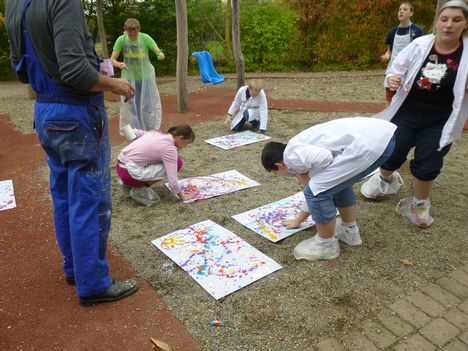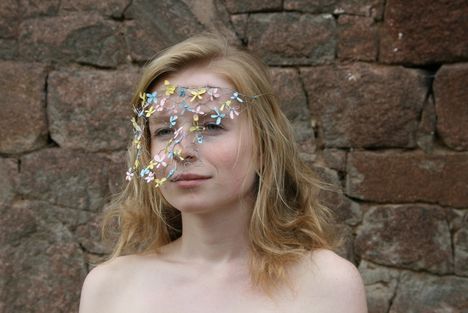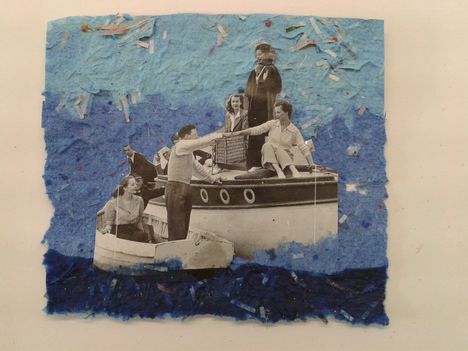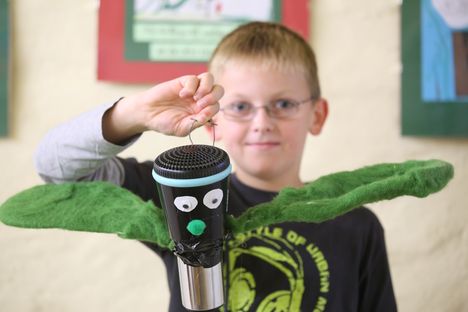Special school “Astrid Lindgren” Halle.
Artistic Director: Mareen Alburg Duncker

Empty coffee and tea capsules served as the basic material. They come in wonderful colors and are easy to shape. Jewelry was thus produced in the first cycle. After this individual work, the second cycle focused on group work. Depending on patience, stamina and motor skills, the work could be large or delicate.
Reinhard Lakomy School, Halberstadt.
Artistic direction: Karl Anton

“Whoops, how did that happen?” Three different ways of using chance in art were tested: Ich erwürfele mir ein Bild -Herbstfarben- Jackson Pollok läßt grüßen – the project is based on the ideas of John Cage by presenting chance as a means of art.
Burggymnasium, Wettin.
Artistic direction: Claudia Baugut

The “mixed” students in grades 10-12 formed a new group, which also got to know each other through their jewelry. The result is “jewelry for me that shows who I am”. The use of natural materials limited the field of design, but also resulted in beautiful objects and “readymades”
Levana School, Eisleben .
Artistic director: Claudia Berg

The pupils were asked to sketch various sculptures and then to create one of them on a large piece of scooped paper using ink. Each pupil worked on a drawing in turn, so that a joint work was created in which each other’s drawing was integrated into the group of other figures. The arrangement of five figures has thus created a new altar.
Neumarkt elementary school, hall. Artistic direction: Marija Falina

The participating second-grade pupils were informed about the project topic in advance by the teacher and were already very excited about the artistic design on the three sub-themes: “My pencil case”, “My break-time breakfast” and “My school bag”. The aim was to introduce the pupils to the topic of everyday life in a playful way and to open up new perspectives on everyday school life.
Youth metal self-help workshop of the open social diaconal youth work of the Magdeburg church district.
Artistic direction: Jörg-Tilmann Hinz

Based on the general theme, the students worked together to look for ways to use supposedly banal everyday technical objects as source material for apparatus-based, kinetic designs.
Secondary school, Landsberg.
Artistic direction: Margit Jakob

Everything collected. Everything found. Thrown away. Rediscovered, looked at and redesigned. All NOTHING SPECIAL. And YET: Suddenly we take a closer look, use our head and our hands and pyramids, amphitheaters, small and large airplanes, pictures, objects, a disco bag … emerge.
Elementary school in Ostrau Castle, Ostrau. Artistic direction: Juliette Kolberg

Based on feeling an everyday object, the children translated what they felt into words, which, again heard by another child, were expressed in a drawing. The multiple translation of the everyday playfully created new forms and objects. Scissors were transformed into a rocket house, a bottle opener into a rabbit nail clipper, a staple …
Elementary school, Klobikau.
Artistic direction: Christiane Jung

Every morning I gave a color lesson. My intention was to produce the colors for the mural in cups of the three primary colors cyan, magenta and yellow, as well as the two achromatic colors black and white. Mixing the colors proves to be an event that never ceases to amaze the children.
Borlach secondary school, Bad Dürrenberg.
Artistic direction: Annekatrin Müller

Since there are no other drawing lessons during the school year, I tried to counteract the general defensive attitude with the words: “I can’t draw.” by using the technique of “frottage”. The pupils worked quite intensively and had many imaginative ideas of their own.
FGS Montessori, Gröningen.
Artistic direction: Josefine Cyranka and Karoline Peisker

The following four art activities were carried out on the school grounds and in the natural environment: Drawing trees on site. Paper printing and book binding. Construction of wooden sculptures. Small sculptures made of wood. The exceptionally nature-loving pupils worked with great interest and concentration on the content on offer and implemented the impulses in a very individual and hands-on manner.
Makarenkoschule (special school for the learning disabled), Halle.
Artistic direction: lnes Zimmermann

What can be the motif of the special in the everyday? Is it a special angle, a particular light or a weather phenomenon in everyday life or an interesting detail? Or could it be a special situation or the clash of opposing worlds?
Burggymnasium, Wettin.
Artistic direction: Katrin Röder

The “material mix” theme thrives on the contrasts of the components. Some students mixed artificial particles such as tinsel and foil with spices and sawdust, while others tried algae and shredded banknotes. The task of creating a leaf from strips posed some problems for some pupils.
Giebichenstein-Gymnasium “Thomas Müntzer” Halle.
Artistic direction: Stefan Scholz

After a preparatory meeting in the school’s print workshop, the week began with the distribution of sketchbooks and drawing pencils. The format was therefore a black book with white pages, which was creatively and individually filled with everyday experiences.
Diemitz elementary school, Freiimfelde.
Artistic direction: Beata Sienko

The students should realize their ideas, come up with new ideas and solutions by working with clay and implement them. They are encouraged to be creative, to experiment and to try out the creative possibilities in “clay”. Using their work as an example, they can impressively follow the change in their tiles in the four different phases.
Elementary school, Salzmünde.
Artistic direction: Silke Trekel

What image do we have of ourselves? Who are we? Who do we want to be? How do the others see us? What image do you have of us? How can we artistically express what we see in ourselves or others? With these questions in mind, we approached the topic by clarifying concepts, drawing, designing and working artistically.
Nördliches Salzatal elementary school, Besenstedt.
Artistic direction: Pauline Ullrich

The book “Hexen, hexen” will be read aloud. The stories should then be written down on paper to accompany the readings. Small picture stories that are later drawn on with pen and ink. The two main characters of the book, the witch and the mouse, are sketched, cut into the linoleum and printed.
Protestant elementary school Zoberberg.
Artistic direction: Katrin Zickler

Together with the museum education service in Dessau, work opportunities and conditions were created for the pupils in the museum that were ideal for getting to know the animals to be depicted and their habitats and thus for carrying out the actual project.
School hostel Gardelegen, Ostrau.
Artistic direction: Beatrix Weißflog

There was the opportunity to playfully try out new forms for what surrounds us every day. Of course, it was also a challenge to create things with clay, which is not an everyday material for most children and which they deal with every day in other materials and dimensions.
IGS Willy Brandt, Magdeburg.
Artistic direction: Uwe Wendler

ART IS? was the question posed to the 21 participants of the art course class 11/4. How do you go about it? Should everyone paint a single picture or all paint one together? Solution: we do both! After some discussions about the HOW, hardboard panels with edge lengths of 0.5 m were processed. The six spectral colors (a piece of the rainbow in the school) were chosen for the colorful design, which, diagonally and strictly separated from each other, form a 2 x 3 m area when put together in a suitable way. A white ribbon winds its way across the picture, on which each pupil has written their answer on the plate they have designed. It can now be admired as a mural between the two art classrooms.
Hegelstraße elementary school, Magdeburg. Artistic direction: Uwe Wendler

The project took place outside of school, eight children, four 2nd class, two each 3. and 4. should create pictures of “What do I see on my way to school?”. On three excursions from the school to the nearby cathedral square and the surrounding area and back, they sketched diligently, from which drafts and finally two 1 x 1.5 m murals on wooden panels (outward and return journey) were created using graphics, painting and collage techniques. In addition to the realization that THE WAY IS THE GOAL and THE GOAL IS THE WAY, the results are impressive and can be seen by everyone in the school building.
Döllnitz elementary school.
Artistic direction: Hendrik Wiethase

The idea was to make everyday objects fly. First, the children had to think about what their flying object should look like, so they made sketches of their ideas. These were examined for their feasibility and modified accordingly. Then it was time to implement the idea in the building. The wings were to be felted to enable a new design and material experience.
Elementary school H. Ch. Andersen, Halle.
Artistic director: Susanne Nickel

The children had worked on the project in their German lessons and had thought about and written down various forms of poetry. I showed the children some of my artist books and explained how the text and the illustrations flow together
Secondary school Campus Technicus, Bernburg.
Artistic direction: Klaus-D. Ullrich and Rosemarie Ullrich

Close observation of only seemingly unimportant details, the little things – the world of florals – are the prerequisites for this project. The two techniques, which are not entirely simple, mean that each work step can build on the previous one. The finished objects are also plastic parts that can be viewed for longer.
